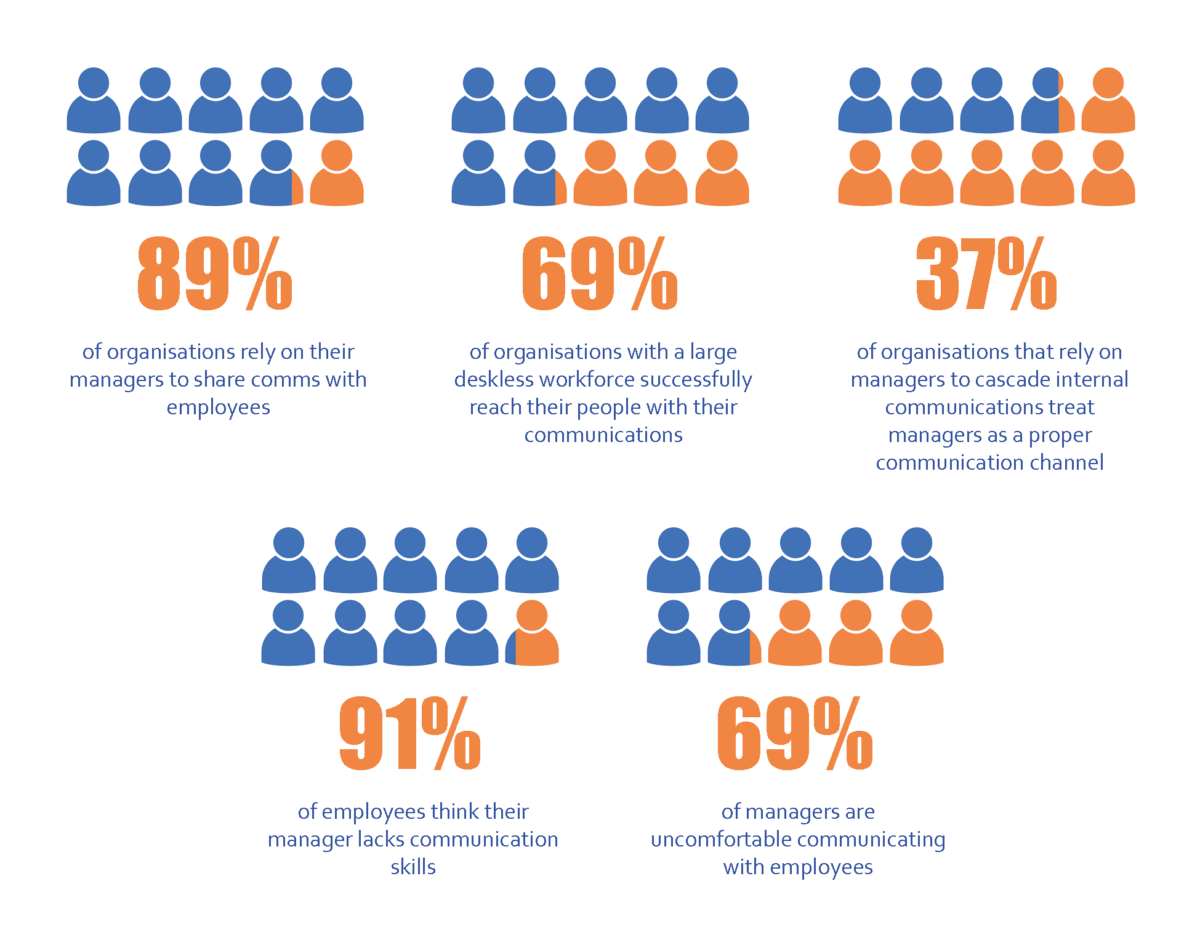
NHS internal communications strategy
What exactly are you trying to achieve with your NHS internal communications strategy? While some goals with differ, others should be the gold standard. Ask yourself these 5 questions.

Managers – we all have one and communication is part of every manager’s role. But do we recognise the importance of managers in our quest to better engage NHS staff? And if we do, as internal communicators, are we supporting them well enough?
To answer these questions, I surveyed over 700 internal communicators asking them whether their internal communications strategy specifically list managers as a standalone communication channel.

Just under two-thirds say they do, which is actually higher than I expected, but the comments I received when undertaking the survey really highlight the challenge… and the purpose of this blog.
The comments included:
“In 20+ years of working in this space, I’ve rarely seen an organisation that understands and supports the importance of manager communication skills.”
“I’ve found that many organisations assume but never set a stated expectation for managers to cascade communications.”
“This is one of the problems I see consistently across big internal comms initiatives.”
Given a third of survey respondents don’t yet consider managers to be a channel, I thought it worthwhile emphasising why managers should have a greater focus within our NHS internal communication strategies.
Nothing speaks louder than some juicy stats to evidence a point so here are a few:

With managers playing such a critical part in communications, but so many of them not feeling comfortable when communicating with employees, it’s important that we carefully consider how to use managers as a communication channel.
Step 1: Include managers as a channel!
The first step is to make sure your NHS managers are actually recognised as a designated channel. Particularly because the tactics you assign to this channel will be different to those you assign to other channels.
Step 2: Consider how your managers will communicate with their teams
Digging deep into the working life of your managers and teams will really help you establish the best way to support them. What are their working patterns? When are they likely to communicate your messages?
Step 3: Consider what your managers will need to communicate
How much information will your line managers need to cascade and how frequently? What formats will be most relevant? How would your managers prefer to receive your communications? How can you maximise efficiencies?
Step 4: Ensure your managers understand your audience
For your managers to be excellent communicators they need to understand the people they are communicating with. While they will know how they work and the performance they give, they may not have put thought into what information is important to them and how the internal communications will impact them.
Sharing this insight and encouraging an empathetic viewpoint will really help them deliver the communications in a way that will resonate with their staff.
Step 5: Ensure managers understand their role
Utilising managers as a communication channel is more than just feeding them communications to share. They need to buy-in to the purpose of the communication. They need to understand the goals and how they, and their team, fit within those goals.
Failure to set the scene in this way will risk the communications being disjointed and not connecting with staff.
Step 6: Have the right tools
If the process of communication isn’t efficient, it probably won’t be done very well. How will you share communications with line managers? Do they need systems or tools to then share the messages with their teams? Consider what you have available and whether they will effectively do the job. If they won’t it may be worth exploring whether there is budget for a collaborative email tool, an employee engagement app, a messaging platform, or a SharePoint drive.
Step 7: Create your manager communication plan
Using all the information you’ve gathered above, create a plan. What are you going to communicate? How often? How will it be circulated? How will you measure performance? What are the feedback loops?
Step 8: Listen
Once you have formally set up managers as a communication channel, ensure you regularly see feedback.
Your managers are on the front line. They will have a lot of valuable insight but this is very likely to be lost due to time limitations. See if you can set time aside to speak to managers – that could be a 2-minute conversation or a 15 minute forum with key line managers. Whatever the method, get as much feedback as possible. How are staff responding? What suggestions do they have for improving internal communications? Not only will you gain greater audience insight, you’ll also increase engagement among your managers.
Step 9: Reciprocate the feedback
Internal communications is a two way process. To keep managers engaged with internal communications they need to know the impact of their input. Share high level feedback and engagement data so they can see the difference it is making.
Step 10: Be approachable
As an internal comms professional you need to be an expert in your field, but you also need to be a sounding board and shoulder to cry on.
At all times, be approachable and let managers know you are available to support them as and when they need it.
Not only will this help them, it will also help you get to know the challenges and concerns of your managers. This will enable you to tailor your support accordingly… and help them evolve your manager-led communications.
With your strategy in place there are additional pointers you can follow to ensure your line managers feel supported when fulfilling their role as communicators.
1. Put together a 101 of internal communications
This is a simple guide that can be given to all incoming managers. It will explain how internal communications work in your Trust and outline what is expected of them in their role as communicators. The guide might include information such as;
2. Make internal communications really easy
Line managers are very busy people – the easier you make it for them to communicate your messages the more likely it will happen. For each communication you could provide a mini toolkit. Your toolkit might include collateral, templates and expected FAQs. It also needs to provide the context behind the communication – why is it being communicated, what will they need to do, and what is the expected outcome?
BUT… don’t overcomplicate it. Your toolkit should be informative but concise. Only include information that is relevant and useful to the line manager. For example, make sure the tone of voice is appropriate for their staff and only include collateral if they are likely to use it.
3. Don’t be overly prescriptive
Linked to the point above, the most receptive communications are delivered naturally. Provide managers with the key points you need them to cover but don’t dictate the communication. Encourage them to discover their own communication style and they, and their team, will be far more invested in the communication.
4. Give them plenty of notice
Where possible, map out your communications as much in advance as possible. Sharing the communications with plenty of notice will allow them to fully absorb the communication before they disseminate it.
5. Understand their challenges
Only when you know the challenges can you help managers overcome them. Take time to understand the barriers your line managers experience when communicating with their teams. They could be anything from language barriers to a lack of confidence. Whatever the barrier, investing time in your managers will further improve the effectiveness of internal communications.
6. Collaborate with other teams
The final point for a reason! This is super important.
You can’t create expert internal communicators single-handedly – particularly if you are responsible for communications in a large Trust. Emphasising the importance of internal communications and nurturing the communication skills of managers goes way beyond your remit. For example, when managers join your Trust, it should be made clear that communicating with their team is a fundamental part of their role. Likewise, any training should include communication skills to help improve the delivery of internal communications.
By having discussions with employee onboarding teams, training teams and senior leaders, you can share your ambitions and strategy to create a small army of ambassadors with their own specialisms all contributing to the same goals.

Operations Director
Passionate about using my 30 yearsof owning my own businesses to help create better workplace environments. A Bon Jovi loving TikTok junkie. I spend most of my time thinking about the impact technology is having on our society. And my pug Winston…

What exactly are you trying to achieve with your NHS internal communications strategy? While some goals with differ, others should be the gold standard. Ask yourself these 5 questions.

Internal comms can help to keep NHS staff healthy – both physically and mentally – but only once we fully understand the potential blockers. This blog brings these barriers to the surface.

Get in touch today to find out how NewZapp can increase the effectiveness of your internal communication.
We are NOT the NHS. We are a supplier of internal communications software. Please contact your local NHS hospital for all healthcare queries.
Tel: 01392 447200
Email: trusteddelivery@newzapp.com
Trusted Delivery is product of NewZapp Communications.
G-Cloud Digital Marketplace Documentation.
NHS Data Security and Protection Toolkit Registration.
Bradley House, Park Five Business Centre, Harrier Way, Exeter, Devon. EX2 7HU.